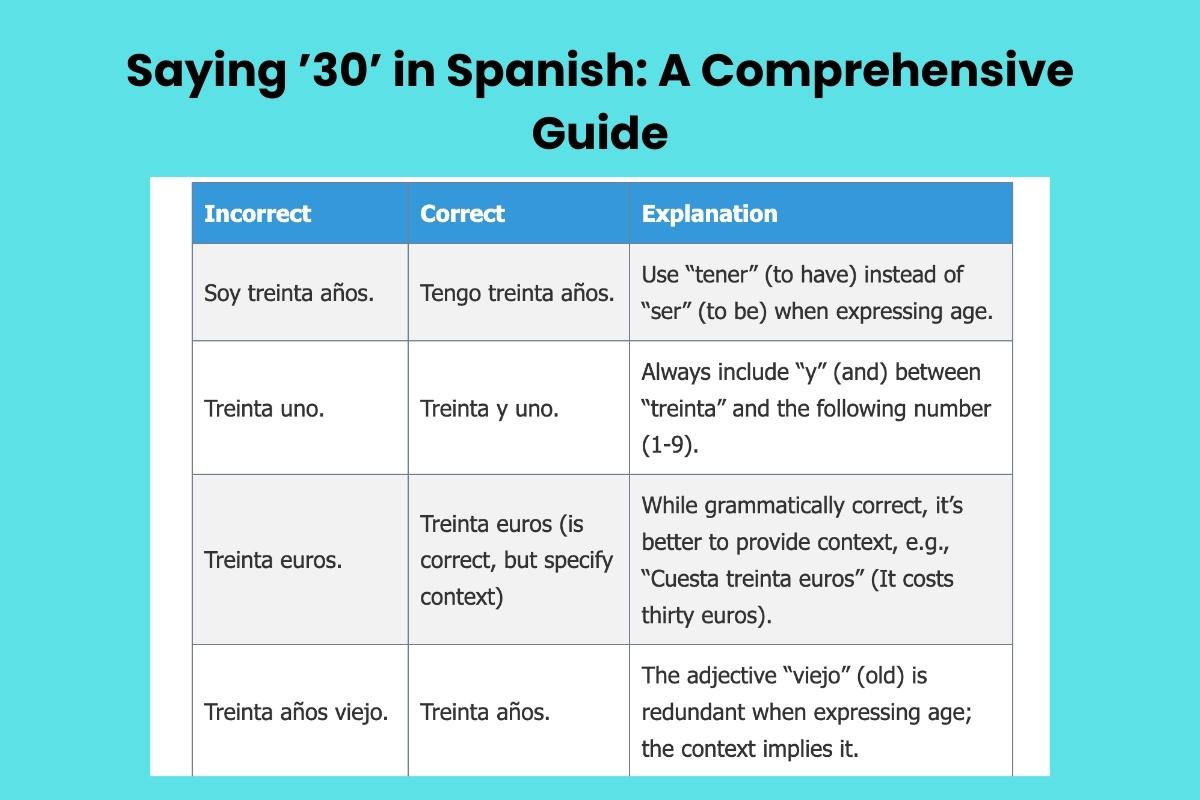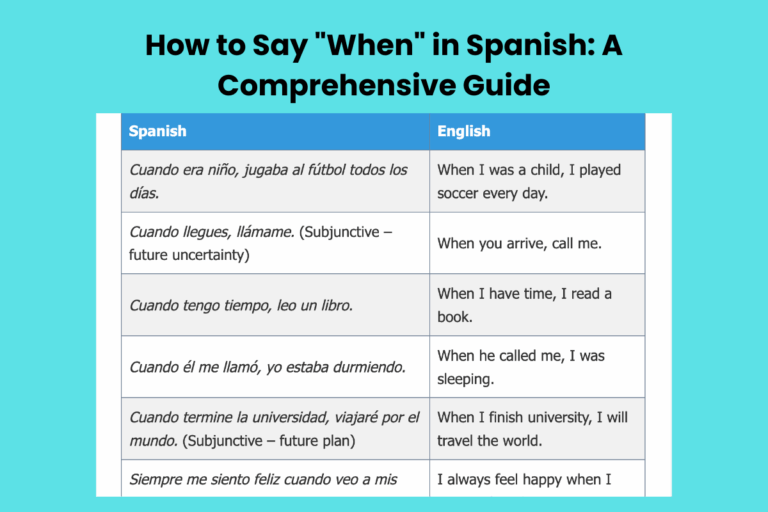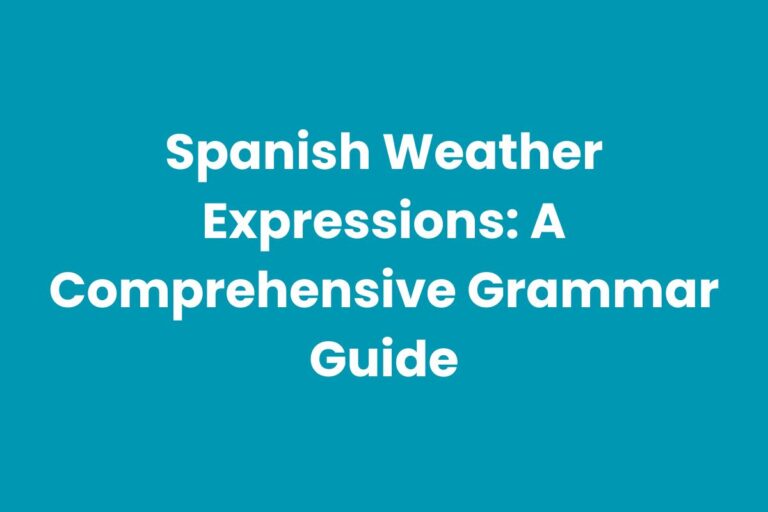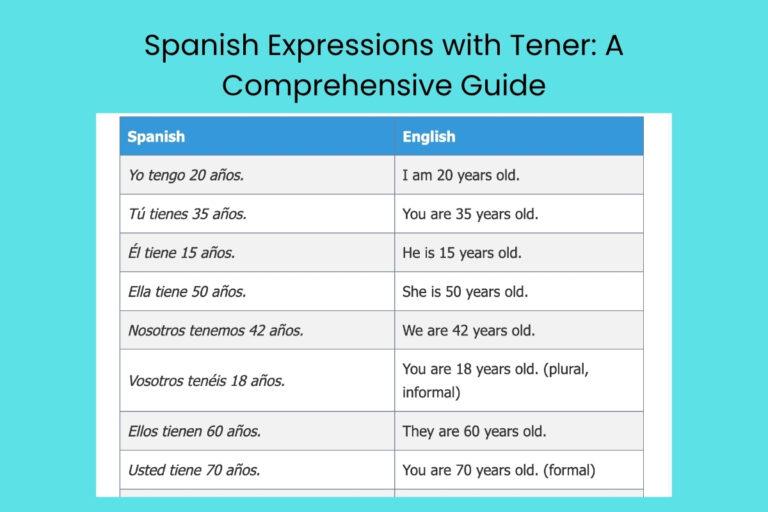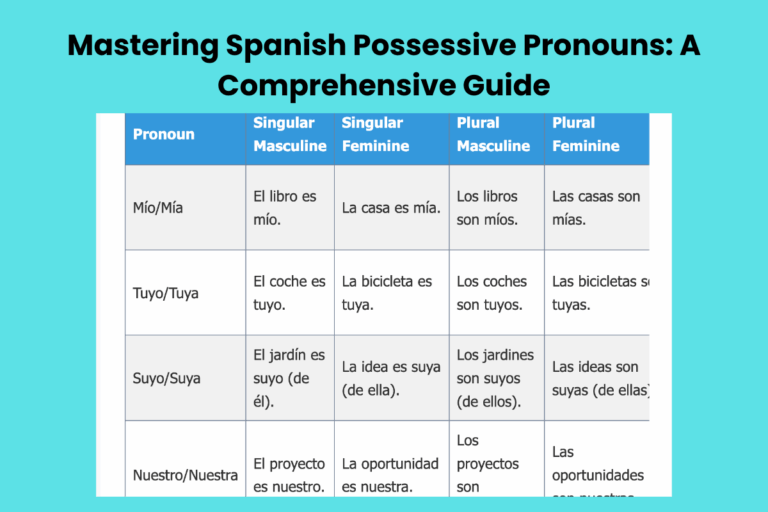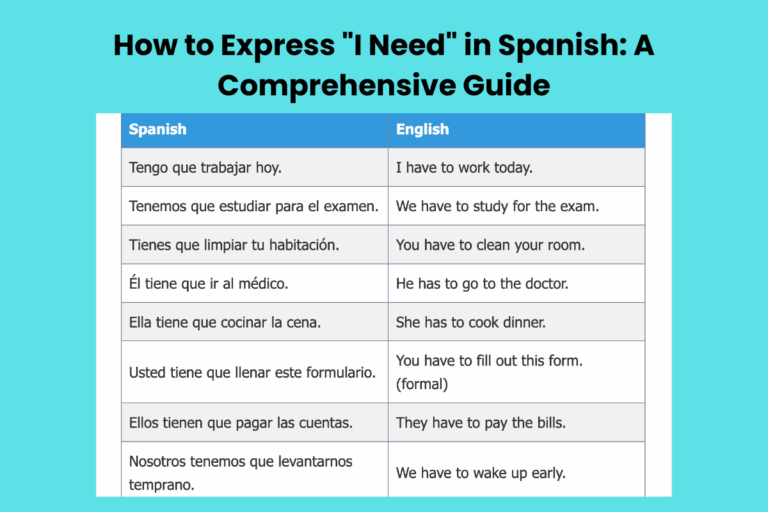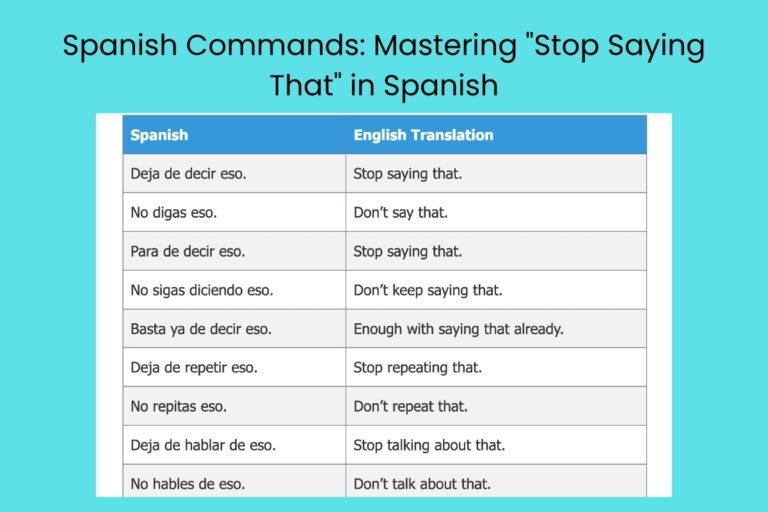Saying ’30’ in Spanish: A Comprehensive Guide
Mastering numbers is a fundamental step in learning any language, and Spanish is no exception. Knowing how to say ’30’ (treinta) is essential for basic communication, whether you’re discussing age, time, prices, or quantities. This article offers a comprehensive guide to understanding and using ‘treinta’ in Spanish, covering its pronunciation, grammatical context, common uses, and potential pitfalls. Whether you’re a beginner or an advanced learner, this guide will provide you with the knowledge and practice needed to confidently use ‘treinta’ in your Spanish conversations.
This article is designed for anyone learning Spanish, from beginners who are just starting to learn numbers to more advanced learners who want to refine their understanding of Spanish grammar and usage. By the end of this article, you will be able to confidently use the number ’30’ in a variety of contexts, understand its grammatical implications, and avoid common mistakes.
Let’s dive in!
Table of Contents
- Introduction
- Definition of Treinta
- Pronunciation of Treinta
- Structural Breakdown of Treinta
- Usage in Sentences
- Compound Numbers with Treinta
- Expressing Age with Treinta
- Using Treinta to Tell Time
- Using Treinta in Monetary Contexts
- Expressing Quantities with Treinta
- Grammatical Agreement
- Gender Agreement
- Number Agreement
- Common Mistakes
- Pronunciation Errors
- Incorrect Combinations
- Practice Exercises
- Exercise 1: Fill in the Blanks
- Exercise 2: Translation
- Exercise 3: Multiple Choice
- Advanced Topics
- Regional Variations
- Idiomatic Expressions
- FAQ
- Conclusion
Definition of Treinta
Treinta is the Spanish word for the number thirty (30). It is a cardinal number, meaning it expresses quantity rather than order. It is used in various contexts, including counting, expressing age, telling time, and discussing money. Understanding its pronunciation and grammatical context is crucial for accurate communication in Spanish.
In the realm of mathematics, treinta represents a whole number between twenty-nine and thirty-one. Its importance transcends mere numerical value; it’s a linguistic building block that allows Spanish speakers to articulate a multitude of concepts. From the mundane—”I need thirty minutes”—to the significant—”She is thirty years old”—treinta is indispensable.
Pronunciation of Treinta
The pronunciation of treinta is relatively straightforward. It is pronounced as “tray-een-tah.” Here’s a breakdown:
- tre: Pronounced like “tray” in English.
- in: Pronounced like “een” in English.
- ta: Pronounced like “tah” in English.
Pay attention to the rolling ‘r’ sound in ‘tre.’ For non-native speakers, this might require some practice. Also, ensure you distinctly pronounce each syllable to avoid confusion.
Structural Breakdown of Treinta
Treinta is a single word, but when forming numbers from 31 to 39, it combines with other numbers using the conjunction “y” (and). For example, 31 is treinta y uno (thirty and one). This pattern continues until 39, which is treinta y nueve (thirty and nine).
The structure is consistent: Treinta + y + [number from 1 to 9]. This structure makes it easy to construct and understand numbers in the thirties.
Usage in Sentences
Treinta can be used in various contexts. Here are some examples:
- Tengo treinta años. (I am thirty years old.)
- El libro cuesta treinta euros. (The book costs thirty euros.)
- Necesito treinta minutos. (I need thirty minutes.)
These examples show how treinta is used to express age, price, and time. The key is to ensure proper grammatical agreement with the subject of the sentence.
Compound Numbers with Treinta
As mentioned earlier, to form numbers between 31 and 39, you combine treinta with “y” and the corresponding number. Here are a few more examples:
- Treinta y dos (Thirty-two)
- Treinta y cinco (Thirty-five)
- Treinta y ocho (Thirty-eight)
The “y” conjunction is crucial. Without it, the number would be incorrect.
Always remember to include “y” when forming these compound numbers.
Expressing Age with Treinta
Expressing age is one of the most common uses of treinta. The phrase Tengo treinta años (I am thirty years old) is a staple for Spanish learners.
Here are more examples of expressing age using treinta:
- Mi hermana tiene treinta y un años. (My sister is thirty-one years old.)
- Su abuelo tiene treinta y cinco años. (His grandfather is thirty-five years old.)
- Ella parece tener treinta y ocho años. (She looks like she is thirty-eight years old.)
Always use the verb tener (to have) when expressing age in Spanish. The phrase translates literally to “I have thirty years.”
Using Treinta to Tell Time
Treinta is also used when telling time. For example, Son las tres y treinta (It’s three thirty).
Here are some more examples:
- Son las cuatro y treinta de la tarde. (It’s four thirty in the afternoon.)
- La reunión es a las diez y treinta de la mañana. (The meeting is at ten thirty in the morning.)
- Llegaremos a las seis y treinta de la noche. (We will arrive at six thirty in the evening.)
When expressing half-past the hour, you can use “y media” instead of “y treinta.” For example, Son las tres y media means the same as Son las tres y treinta (It’s three thirty).
Using Treinta in Monetary Contexts
When discussing prices or amounts of money, treinta is commonly used.
Examples:
- El coche cuesta treinta mil euros. (The car costs thirty thousand euros.)
- Gané treinta dólares la semana pasada. (I earned thirty dollars last week.)
- Necesito treinta pesos para el autobús. (I need thirty pesos for the bus.)
Remember to specify the currency when discussing money to avoid confusion.
Expressing Quantities with Treinta
Treinta is used to express quantities of objects or people.
Examples:
- Hay treinta estudiantes en la clase. (There are thirty students in the class.)
- Compré treinta manzanas en el mercado. (I bought thirty apples at the market.)
- Necesito treinta sillas para la fiesta. (I need thirty chairs for the party.)
Ensure that the noun you are quantifying agrees in gender and number with the rest of the sentence.
Grammatical Agreement
In Spanish, grammatical agreement is crucial. While treinta itself doesn’t change, the nouns and adjectives it modifies must agree in gender and number.
Gender Agreement
Gender agreement refers to matching the gender (masculine or feminine) of the nouns with the articles and adjectives that describe them. Since treinta is a number, it doesn’t directly affect gender agreement. However, the nouns it modifies do.
For example:
- Treinta libros (Thirty books – masculine plural)
- Treinta revistas (Thirty magazines – feminine plural)
The number treinta remains constant, but the nouns libros and revistas are either masculine or feminine, respectively.
Number Agreement
Number agreement refers to matching the number (singular or plural) of the nouns with the verbs and adjectives that describe them. When using treinta, the noun will almost always be plural since you are referring to a quantity greater than one.
For example:
- Hay treinta personas aquí. (There are thirty people here.)
- Compré treinta boletos. (I bought thirty tickets.)
In both examples, the nouns personas and boletos are plural.
Common Mistakes
Even experienced learners make mistakes. Here are some common errors to avoid when using treinta.
Pronunciation Errors
One common mistake is mispronouncing the ‘r’ sound in treinta. Remember to roll the ‘r’ slightly, especially if you are not a native speaker.
Another error is not pronouncing all syllables distinctly. Make sure to clearly say “tray-een-tah.”
Incorrect Combinations
A common mistake is forgetting the “y” when forming compound numbers like 31, 32, etc. Always remember to say treinta y uno, treinta y dos, etc.
Another error is using the wrong verb when expressing age. Remember to use tener (to have) instead of ser (to be). For example, say Tengo treinta años (I am thirty years old) instead of Soy treinta años (which is incorrect).
Here is a table of common mistakes when using the number 30 in Spanish:
| Incorrect | Correct | Explanation |
|---|---|---|
| Soy treinta años. | Tengo treinta años. | Use “tener” (to have) instead of “ser” (to be) when expressing age. |
| Treinta uno. | Treinta y uno. | Always include “y” (and) between “treinta” and the following number (1-9). |
| Treinta euros. | Treinta euros (is correct, but specify context) | While grammatically correct, it’s better to provide context, e.g., “Cuesta treinta euros” (It costs thirty euros). |
| Treinta años viejo. | Treinta años. | The adjective “viejo” (old) is redundant when expressing age; the context implies it. |
| Treinta personas es aquí. | Treinta personas están aquí. | Use “estar” (to be) in the plural form “están” to agree with the plural subject “personas.” |
| Treinta libro. | Treinta libros. | The noun must be plural to match the quantity. |
| Treinta manzana. | Treinta manzanas. | The noun must be plural to match the quantity. |
| Treinta minuto. | Treinta minutos. | The noun must be plural to match the quantity. |
| Treinta dolares. | Treinta dólares. | Spanish speakers often use the accent mark. |
| La reunion es a las diez y treinta de mañana. | La reunion es a las diez y treinta de la mañana. | Use “de la mañana” to say “in the morning.” |
| Treinta de gente. | Treinta personas. | “Gente” means “people,” but “personas” is more specific for counting. |
| Treinta de los estudiantes. | Treinta estudiantes. | Avoid unnecessary use of “de los” when referring to a general group. |
| Yo tengo treinta. | Yo tengo treinta años. | While understandable, it’s better to specify “años” (years) for clarity. |
| Es treinta. | Son las seis y treinta. | When telling time, use “Son las” for times after 1:00. |
| Treinta y dies. | Cuarenta. | “Treinta y diez” is not a correct compound number. Use “cuarenta” (forty). |
| Treinta y once. | Cuarenta y uno. | “Treinta y once” is not a correct compound number. Use “cuarenta y uno” (forty one). |
| Treinta y doce. | Cuarenta y dos. | “Treinta y doce” is not a correct compound number. Use “cuarenta y dos” (forty two). |
| Treinta y trece. | Cuarenta y tres. | “Treinta y trece” is not a correct compound number. Use “cuarenta y tres” (forty three). |
| La clase tiene treintas estudiantes. | La clase tiene treinta estudiantes. | “Treintas” is not a word. Always use “treinta.” |
Practice Exercises
To solidify your understanding, here are some practice exercises.
Exercise 1: Fill in the Blanks
Complete the following sentences with the correct form of treinta.
| Question | Answer |
|---|---|
| Yo tengo __________ años. | treinta |
| El libro cuesta __________ euros. | treinta |
| Necesito __________ minutos. | treinta |
| Hay __________ estudiantes en la clase. | treinta |
| Compré __________ manzanas. | treinta |
| Su abuelo tiene __________ y dos años. | treinta |
| Son las seis y __________. | treinta |
| El coche cuesta __________ mil euros. | treinta |
| Hay __________ casas en mi calle. | treinta |
| El tiene __________ y nueve años. | treinta |
Exercise 2: Translation
Translate the following sentences into Spanish using treinta.
| Question | Answer |
|---|---|
| I am thirty years old. | Tengo treinta años. |
| The shirt costs thirty dollars. | La camisa cuesta treinta dólares. |
| We need thirty chairs. | Necesitamos treinta sillas. |
| It’s three thirty. | Son las tres y treinta. |
| There are thirty people here. | Hay treinta personas aquí. |
| She is thirty-five years old. | Ella tiene treinta y cinco años. |
| The meeting is at ten thirty. | La reunión es a las diez y treinta. |
| I have thirty cousins. | Tengo treinta primos. |
| The test has thirty questions. | El examen tiene treinta preguntas. |
| He spent thirty euros. | Él gastó treinta euros. |
Exercise 3: Multiple Choice
Choose the correct option.
| Question | Answer |
|---|---|
| Which is the correct way to say “thirty-one”? | Treinta y uno |
| The correct way to say “I am thirty years old” is: | Tengo treinta años. |
| How do you say “It’s six thirty”? | Son las seis y treinta. |
| The correct way to say “thirty books” is: | Treinta libros. |
| Which of the following is incorrect? | Soy treinta años. |
| How do you say “thirty two”? | Treinta y dos. |
| How do you say “thirty five”? | Treinta y cinco. |
| How do you say “thirty eight”? | Treinta y ocho. |
| How do you say “thirty nine”? | Treinta y nueve. |
| Which of the following is incorrect? | Treinta uno. |
Advanced Topics
For advanced learners, here are some more complex aspects of using treinta in Spanish.
Regional Variations
While the basic usage of treinta is consistent across Spanish-speaking countries, there might be slight regional variations in pronunciation or idiomatic expressions. For example, the pronunciation of the ‘r’ sound can vary from country to country.
In some regions, you might hear different ways of expressing time. While Son las tres y treinta is standard, some regions might prefer using “y media” more frequently.
Idiomatic Expressions
There are not many common idiomatic expressions that directly use the number ‘treinta’. However, understanding the cultural context in which numbers are used is crucial.
For example, certain ages might have cultural significance in different countries.
Here is a table of idiomatic expressions that may be indirectly related to the number 30 in Spanish:
| Idiomatic Expression | Literal Translation | Meaning | Example |
|---|---|---|---|
| Tener una treintena de… | To have about thirty… | To have approximately thirty of something. | Tengo una treintena de libros en mi estantería. (I have about thirty books on my shelf.) |
| No tener ni treinta pelos en la cabeza | Not to have even thirty hairs on one’s head | To be bald or to have very little hair. | Mi abuelo ya no tiene ni treinta pelos en la cabeza. (My grandfather doesn’t even have thirty hairs on his head anymore.) |
| A los treinta y tantos | In one’s thirty-somethings | To be in the age range of thirty to thirty-nine. | Ella está en los treinta y tantos. (She is in her thirty-somethings.) |
| Estar en la treintena | To be in one’s thirties | To be in the age range of thirty to thirty-nine. | Él está en la treintena y todavía no se ha casado. (He is in his thirties and still hasn’t gotten married.) |
| Valer treinta duros | To be worth thirty “duros” | To be worth very little (historically, a “duro” was a five-peseta coin). | Ese viejo coche no vale ni treinta duros. (That old car isn’t worth even thirty “duros.”) |
FAQ
- How do you pronounce treinta?
Treinta is pronounced “tray-een-tah.” Remember to roll the ‘r’ sound slightly.
- What is the difference between treinta and treinta y uno?
Treinta means thirty, while treinta y uno means thirty-one.
- When do I use “y” with treinta?
You use “y” when forming compound numbers from 31 to 39. For example, treinta y dos (thirty-two).
- How do I express age using treinta?
Use the verb tener (to have). For example, Tengo treinta años (I am thirty years old).
- Can I say Soy treinta años?
No, that is incorrect. You must use Tengo treinta años.
- How do I say “It’s three thirty” in Spanish?
You can say Son las tres y treinta or Son las tres y media.
- Is there any regional variation in using treinta?
While the basic usage is consistent, there might be slight variations in pronunciation or idiomatic expressions.
- How do you say “about thirty” in Spanish?
You can say “alrededor de treinta” or “una treintena de”.
- What is the best way to practice using treinta?
Practice using it in sentences, conversations, and real-life situations. Try to think of things around you that are in quantities of thirty, or use it when discussing prices and times.
- Are there any common mistakes to avoid when using treinta?
Yes, avoid mispronouncing the ‘r’ sound, forgetting the “y” in compound numbers, and using the wrong verb when expressing age.
Conclusion
Understanding how to say ’30’ in Spanish, treinta, is a fundamental step in mastering the language. This guide has covered its definition, pronunciation, grammatical context, and common uses. By understanding how to form compound numbers, express age, tell time, and discuss money using treinta, you can greatly improve your communication skills in Spanish.
Remember to practice regularly and be mindful of common mistakes. With consistent effort, you will confidently use treinta in your Spanish conversations. Don’t hesitate to immerse yourself in the language, whether through conversations with native speakers, watching Spanish-language media, or further exploring advanced grammar topics. ¡Buena suerte! (Good luck!)

